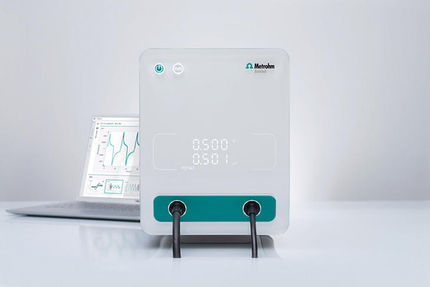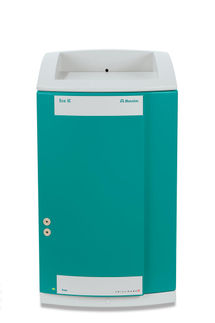Hypokalemia
Classification & external resources
|
|
| Potassium
|
| ICD-10
| E87.6
|
| ICD-9
| 276.8
|
| DiseasesDB
| 6445
|
| MedlinePlus
| 000479
|
| eMedicine
| emerg/273
|
| MeSH
| D007008
|
Hypokalemia refers to the condition in which the concentration of potassium in the blood is low. The prefix hypo- means low (contrast with hyper-, meaning high). Kal refers to kalium, the Neo-Latin for potassium, and -emia means "in the blood". The total potassium in the human body is approximately 3500 mEq for a 70 kg adult; at least 95% of the body's potassium is found inside cells, with the remainder in the blood. This concentration gradient is maintained principally by the Na+/K+-ATPase pump.
Pathohysiology
Potassium is essential for many body functions, including muscle and nerve activity. The electrochemical gradient of potassium between the intracellular and extracellular space is essential for nerve function; in particular, potassium is needed to repolarize the cell membrane to a resting state after an action potential has passed. Decreased potassium levels in the extracellular space will cause hyperpolarization of the resting membrane potential. This hyperpolarization is caused by the effect of the altered potassium gradient on resting membrane potential as defined by the Goldman equation. As a result, a greater than normal stimulus is required for depolarization of the membrane in order to initiate an action potential. In certain conditions, this will make cells less excitable. However, in the heart, it causes myocytes to become hyperexcitable. This is due to two independent effects that may lead to aberrant cardiac conduction and subsequent arrhythmia: 1) there are more inactivated sodium (Na) channels available to fire, and 2) the overall potassium permeability of the ventricle is reduced (perhaps by the loss of a direct effect of extracellular potassium on some of the potassium channels).
Causes
Hypokalemia can result from one or more of the following medical conditions:
- Perhaps the most obvious cause is insufficient consumption of potassium (that is, a low-potassium diet). However, without excessive potassium loss from the body, this is a rare cause of hypokalemia.
- A more common cause is excessive loss of potassium, often associated with heavy fluid losses that "flush" potassium out of the body. Typically, this is a consequence of vomiting, diarrhea, excessive perspiration, or losses associated with surgical procedures
- A special case of potassium loss occurs with diabetic ketoacidosis. In addition to urinary losses from polyuria and volume contraction, there is also obligate loss of potassium from kidney tubules as a cationic partner to the negatively charged ketone, β-hydroxybutyrate.
- Hypomagnesemia can cause hypokalemia. Magnesium is required for adequate processing of potassium. This may become evident when hypokalemia persists despite potassium supplementation. Other electrolyte abnormalities may also be present.
- Disease states that lead to abnormally high aldosterone levels can cause hypertension and excessive urinary losses of potassium. These include renal artery stenosis and tumors (generally non-malignant) of the adrenal glands. Hypertension and hypokalemia can also be seen with a deficiency of the 11β-hydroxylase enzyme which allows cortisols to stimulate aldosterone receptors. This deficiency can either be congenital or caused by consumption of glycyrrhizin, which is contained in extract of licorice, sometimes found in Herbal supplements, candies and chewing tobacco.
- Rare hereditary defects of renal salt transporters, such as Bartter syndrome or Gitelman syndrome can cause hypokalemia, in a manner similar to that of diuretics.
- Rare hereditary defects of muscular ion channels and transporters that cause hypokalemic periodic paralysis can precipitate occasional attacks of severe hypokalemia and muscle weakness. These defects cause a heightened sensitivity to catechols and/or insulin and/or thyroid hormone that lead to sudden influx of potassium from the extracellular fluid into the muscle cells.
Signs and symptoms
Mild hypokalemia is often without symptoms, although it may cause a small elevation of blood pressure[1], and can occasionally provoke cardiac arrhythmias. Moderate hypokalemia may cause muscular weakness, myalgia, and muscle cramps (owing to disturbed function of the skeletal muscles), and constipation (from disturbed function of smooth muscles). With more severe hypokalemia, flaccid paralysis, hyporeflexia, and tetany may result. There are reports of rhabdomyolysis occurring with profound hypokalemia. Respiratory depression from severe impairment of skeletal muscle function is not uncommon.
Some electrocardiographic (ECG) findings associated with hypokalemia are flattened T waves, U waves, ST segment depression, and prolongation of the QT interval.
Treatment
The most important step in severe hypokalemia is removing the cause, such as treating diarrhea or stopping offending medication.
Mild hypokalemia (>3.0 mEq/L) may be treated with oral potassium chloride supplements (Sando-K®, Slow-K®). As this is often part of a poor nutritional intake, potassium-containing foods may be recommended, such as tomatoes, oranges or bananas. Both dietary and pharmaceutical supplements are used for people taking diuretic medications (see Causes, above).
Severe hypokalemia (<3.0 mEq/L) may require intravenous supplementation. Typically, saline is used, with 20-40 mEq KCl per liter over 3-4 hours. Giving intravenous potassium at faster rates may predispose to ventricular tachycardias and requires intensive monitoring.
Difficult or resistant cases of hypokalemia may be amenable to amiloride, a potassium-sparing diuretic, or spironolactone.
When replacing potassium intravenously, infusion via central line is encouraged to avoid the frequent occurrence of a burning sensation at the site of a peripheral iv, or the rare occurrence of damage to the vein. When peripheral infusions are necessary, the burning can be reduced by diluting the potassium in larger amounts of IV fluid, or mixing 3 ml of 1% lidocaine to each 10 meq of kcl per 50 ml of IV fluid. The practice of adding lidocaine, however, raises the likelihood of serious medical errors [1].
Hypokalemia in pets
Cats can develop hypokalemia in old age, but Burmese kittens may be genetically prone to the condition if both parents have a defective gene. Symptoms are: staggering, an inability to keep up head which droops alarmingly and animals have good appetite but fail to gain weight. Treatment is by adding ground potassium tablets to the animal's food.
See also
References
- ^ Krishna GG et al. (1989) Increased blood pressure during potassium depletion in normotensive men. N Engl J Med., 320(18):1177-82; PMID 2624617.
- Kasper DL et al (Eds). Harrison's Principles of Internal Medicine, 16th ed, chapter 41, pages 258-61. ISBN 0-07-140235-7.
- Rose, B.D. and T.W. Post, Clinical Physiology of Acid-Base and Electrolyte Disorders, 5th ed. 2001, pages 836-887. ISBN 0-07-134682-1
- Feline Hypokalemic Polymyopathy. in The Merck Veterinary Manual, 9th edition By Merck & Co. 2006. ISBN 0-911910-50-6
| Metabolic pathology / Inborn error of metabolism (E70-90, 270-279) |
|---|
| Amino acid | Aromatic (Phenylketonuria, Alkaptonuria, Ochronosis, Tyrosinemia, Albinism, Histidinemia) - Organic acidemias (Maple syrup urine disease, Propionic acidemia, Methylmalonic acidemia, Isovaleric acidemia, 3-Methylcrotonyl-CoA carboxylase deficiency) - Transport (Cystinuria, Cystinosis, Hartnup disease, Fanconi syndrome, Oculocerebrorenal syndrome) - Sulfur (Homocystinuria, Cystathioninuria) - Urea cycle disorder (N-Acetylglutamate synthase deficiency, Carbamoyl phosphate synthetase I deficiency, Ornithine transcarbamylase deficiency, Citrullinemia, Argininosuccinic aciduria, Hyperammonemia) - Glutaric acidemia type 1 - Hyperprolinemia - Sarcosinemia |
|---|
| Carbohydrate | Lactose intolerance - Glycogen storage disease (type I, type II, type III, type IV, type V, type VI, type VII) - fructose metabolism (Fructose intolerance, Fructose bisphosphatase deficiency, Essential fructosuria) - galactose metabolism (Galactosemia, Galactose-1-phosphate uridylyltransferase galactosemia, Galactokinase deficiency) - other intestinal carbohydrate absorption (Glucose-galactose malabsorption, Sucrose intolerance) - pyruvate metabolism and gluconeogenesis (PCD, PDHA) -
Pentosuria - Renal glycosuria |
|---|
| Lipid storage | Sphingolipidoses/Gangliosidoses: GM2 gangliosidoses (Sandhoff disease, Tay-Sachs disease) - GM1 gangliosidoses - Mucolipidosis type IV - Gaucher's disease - Niemann-Pick disease - Farber disease - Fabry's disease - Metachromatic leukodystrophy - Krabbe disease
Neuronal ceroid lipofuscinosis (Batten disease) - Cerebrotendineous xanthomatosis - Cholesteryl ester storage disease (Wolman disease) |
|---|
| Fatty acid metabolism | Lipoprotein/lipidemias: Hyperlipidemia - Hypercholesterolemia - Familial hypercholesterolemia - Xanthoma - Combined hyperlipidemia - Lecithin cholesterol acyltransferase deficiency - Tangier disease - Abetalipoproteinemia
Fatty acid: Adrenoleukodystrophy - Acyl-coA dehydrogenase (Short-chain, Medium-chain, Long-chain 3-hydroxy, Very long-chain) - Carnitine (Primary, I, II) |
|---|
| Mineral | Cu Wilson's disease/Menkes disease - Fe Haemochromatosis - Zn Acrodermatitis enteropathica - PO43�' Hypophosphatemia/Hypophosphatasia - Mg2+ Hypermagnesemia/Hypomagnesemia - Ca2+ Hypercalcaemia/Hypocalcaemia/Disorders of calcium metabolism |
|---|
Fluid, electrolyte
and acid-base balance | Electrolyte disturbance - Na+ Hypernatremia/Hyponatremia - Acidosis (Metabolic, Respiratory, Lactic) - Alkalosis (Metabolic, Respiratory) - Mixed disorder of acid-base balance - H2O Dehydration/Hypervolemia - K+ Hypokalemia/Hyperkalemia - Cl�' Hyperchloremia/Hypochloremia |
|---|
| Purine and pyrimidine | Hyperuricemia - Lesch-Nyhan syndrome - Xanthinuria |
|---|
| Porphyrin | Acute intermittent, Gunther's, Cutanea tarda, Erythropoietic, Hepatoerythropoietic, Hereditary copro-, Variegate |
|---|
| Bilirubin | Unconjugated (Lucey-Driscoll syndrome, Gilbert's syndrome, Crigler-Najjar syndrome) - Conjugated (Dubin-Johnson syndrome, Rotor syndrome) |
|---|
| Glycosaminoglycan | Mucopolysaccharidosis - 1:Hurler/Hunter - 3:Sanfilippo - 4:Morquio - 6:Maroteaux-Lamy - 7:Sly |
|---|
| Glycoprotein | Mucolipidosis - I-cell disease - Pseudo-Hurler polydystrophy - Aspartylglucosaminuria - Fucosidosis - Alpha-mannosidosis - Sialidosis |
|---|
| Other | Alpha 1-antitrypsin deficiency - Cystic fibrosis - Amyloidosis (Familial Mediterranean fever) - Acatalasia |
|---|
|







